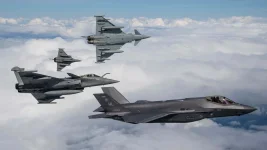- Views: 2K
- Replies: 10

South Korea's KF-21 Boramae program has set a remarkable pace in fighter jet development, achieving 1,000 accident-free flight sorties in just over two years since its maiden flight in July 2022. This accomplishment underscores the program's efficiency, safety standards, and commitment to timelines, offering valuable lessons for India's own Advanced Medium Combat Aircraft (AMCA) program.
The KF-21's rapid progress highlights the effectiveness of South Korea's robust developmental and testing protocols. During its flight tests, the KF-21 has demonstrated exceptional safety, reliability, and performance across various domains, including structural integrity, avionics systems, aerodynamics, and advanced combat scenarios. This achievement serves as a testament to South Korea's engineering prowess and its streamlined approach to fighter aircraft development.
As India anticipates the first flight of its AMCA in 2028, comparisons with the KF-21's rapid development are inevitable. The Light Combat Aircraft (LCA) Tejas program, India's previous indigenous fighter jet development endeavor, provides a stark contrast. The LCA Tejas took nearly eight years to achieve 1,000 flight sorties after its maiden flight in 2001. This slower pace, averaging around 100 sorties per year in its early development, led to significant delays in meeting testing milestones and achieving full operational capability.
To emulate the KF-21's success and accelerate the AMCA's development, India needs to adopt a highly accelerated flight testing schedule, potentially conducting 2-3 sorties daily to reach 1,000 sorties within a comparable timeframe. This would require a multi-pronged approach:
- Dedicated Flight Testing Infrastructure: Establishing multiple, well-equipped test centers with advanced simulation and analysis capabilities would be crucial to support the increased flight test frequency.
- Sufficient Prototypes: Building a larger fleet of test prototypes would enable parallel testing, accelerating data collection and reducing reliance on a single aircraft.
- Streamlined Testing Protocols: Leveraging automation, simulation, and real-time data analysis would help minimize the time between sorties and optimize the testing process.
- Strong Industry Collaboration: Involving both private and public sector entities in testing and certification would foster a collaborative ecosystem and expedite the development process.

